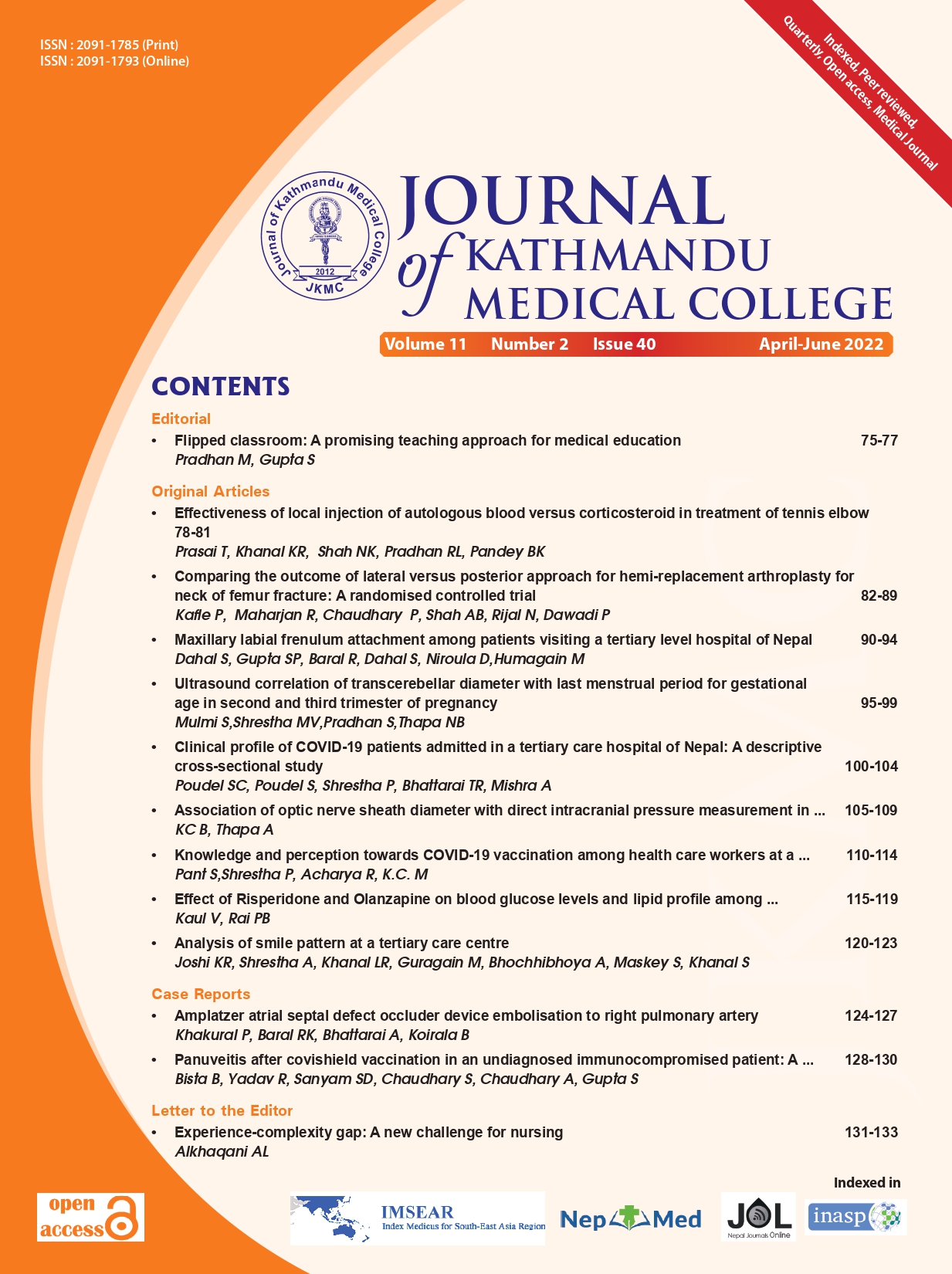Analysis of smile pattern at a tertiary care centre
DOI:
https://doi.org/10.3126/jkmc.v11i2.49092Keywords:
Lip, Prevalence, Smile line, SmilingAbstract
Background: The treatment of the aesthetic region of mouth is complicated. Knowledge of the smile pattern which includes smile line, smile curvature, smile arc, labiodental relation, and tooth exposed determines the success of treatment. This is helpful in the diagnosis and treatment planning phases of aesthetic dentistry.
Objectives: To determine the smile pattern in aesthetic region and to compare the different smile patterns.
Methods: This analytical cross-sectional study was done in the department of Prosthodontics and Maxillofacial Prosthesis, Universal College of Medical Sciences, Nepal from 15th October 2021 to 15th March 2022. A total number of 355 samples were taken by convenience sampling technique. After receiving participant’s consent, study was carried out using a digital camera. The camera was set to primarily capture the area between nose and chin, with lens parallel to the apparent occlusal plane of the participants. For study purpose, individuals were told to sit and hold head normally with their head in level with Frankfort horizontal plane.
Results: The total number of participants were 355 out of which 153 (43.09%) were male and 202 (56.91%) were female. In the smile line pattern, the “Average” smile line was prevalent in a maximum number of participants (223, 62.8%) followed by the high and low smile lines. There was a significant relationship between the smile arc, labiodental relationship, and the tooth displayed.
Conclusion: The findings of this study determines the smile pattern of this region, thus this will be helpful in the diagnosis and treatment planning during the treatment.
Downloads
References
1. Desai S, Upadhyay M, Nanda R. Dynamic smile analysis: changes with age. Am J Orthod dentofacial orthop. 2009 Sep 1;136(3):310-e1. [PubMed | DOI | Full Text]
Machado AW. 10 commandments of smile aaesthetics. Dental Press Journal of Orthodontics. 2014 Jul;19:136-57. [ PubMed | DOI | FullText]
Pinzan-Vercelino CR, Costa AC, Ferreira MC, Bramante FS, Fialho MP, de Araújo Gurgel J. Comparison of gingival display in smile attractiveness among restorative dentists, orthodontists, prosthodontists, periodontists, and laypeople. The Journal of prosthetic dentistry. 2020 Feb 1;123(2):314-21. [PubMed | DOI | Full Text]
Basnet BB, Limbu IK, Parajuli PK. A photographic evaluation of factors prevalent in Nepalese smile: A cross-sectional study. Journal of Dental Specialities. 2018 Sep;6(2):121-5. . [DOI | Full Text]
Khan M, Kazmi SM, Khan FR, Samejo I. Analysis of different characteristics of smile. BDJ open. 2020 May 5;6(1):1-5. [PubMed | DOI| Full Text]
Tjan AH, Miller GD. Some esthetic factors in a smile. The Journal of prosthetic dentistry. 1984 Jan 1;51(1):24-8. [PubMed | DOI| Full Text]
Nold SL, Horvath SD, Stampf S, Blatz MB. Analysis of select facial and dental esthetic parameters. Int J Periodontics Restorative Dent. 2014 Sep 1;34(5):623-9. [PubMed | DOI| Full Text]
Hulsey CM. An esthetic evaluation of lip-teeth relationships present in the smile. American journal of orthodontics. 1970 Feb 1;57(2):132-44. [PubMed | DOI]
Liang LZ, Hu WJ, Zhang YL, Chung KH. Analysis of dynamic smile and upper lip curvature in young Chinese. International journal of oral science. 2013 Apr;5(1):49-53. [PubMed | DOI| Full Text]
Maulik C, Nanda R. Dynamic smile analysis in young adults. American journal of orthodontics and dentofacial orthopedics. 2007 Sep 1;132(3):307-15. [PubMed | DOI| Full Text]
Nold SL, Horvath SD, Stampf S, Blatz MB. Analysis of select facial and dental esthetic parameters. Int J Periodontics Restorative Dent. 2014 Sep 1;34(5):623-9. [PubMed | DOI| Full Text]
Agarwal R, Pillai LK. A study to evaluate some of the esthetic factors determining attractive smile. International Journal of Prosthodontics and Restorative Dentistry. 2016 Jun 1;6(2):31-6. [ Full Text]
Downloads
Published
How to Cite
Issue
Section
License
Copyright © Journal of Kathmandu Medical College
The ideas and opinions expressed by authors or articles summarized, quoted, or published in full text in this journal represent only the opinions of the authors and do not necessarily reflect the official policy of Journal of Kathmandu Medical College or the institute with which the author(s) is/are affiliated, unless so specified.
Authors convey all copyright ownership, including any and all rights incidental thereto, exclusively to JKMC, in the event that such work is published by JKMC. JKMC shall own the work, including 1) copyright; 2) the right to grant permission to republish the article in whole or in part, with or without fee; 3) the right to produce preprints or reprints and translate into languages other than English for sale or free distribution; and 4) the right to republish the work in a collection of articles in any other mechanical or electronic format.




